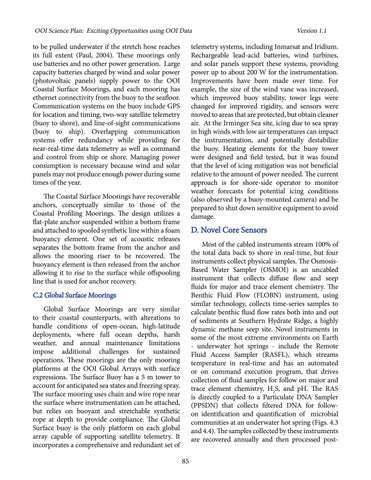OOI Science Plan: Exciting Opportunities using OOI Data
to be pulled underwater if the stretch hose reaches its full extent (Paul, 2004). These moorings only use batteries and no other power generation. Large capacity batteries charged by wind and solar power (photovoltaic panels) supply power to the OOI Coastal Surface Moorings, and each mooring has ethernet connectivity from the buoy to the seafloor. Communication systems on the buoy include GPS for location and timing, two-way satellite telemetry (buoy to shore), and line-of-sight communications (buoy to ship). Overlapping communication systems offer redundancy while providing for near-real-time data telemetry as well as command and control from ship or shore. Managing power consumption is necessary because wind and solar panels may not produce enough power during some times of the year.
Version 1.1
telemetry systems, including Inmarsat and Iridium. Rechargeable lead-acid batteries, wind turbines, and solar panels support these systems, providing power up to about 200 W for the instrumentation. Improvements have been made over time. For example, the size of the wind vane was increased, which improved buoy stability, tower legs were changed for improved rigidity, and sensors were moved to areas that are protected, but obtain cleaner air. At the Irminger Sea site, icing due to sea spray in high winds with low air temperatures can impact the instrumentation, and potentially destabilize the buoy. Heating elements for the buoy tower were designed and field tested, but it was found that the level of icing mitigation was not beneficial relative to the amount of power needed. The current approach is for shore-side operator to monitor weather forecasts for potential icing conditions (also observed by a buoy-mounted camera) and be prepared to shut down sensitive equipment to avoid damage.
The Coastal Surface Moorings have recoverable anchors, conceptually similar to those of the Coastal Profiling Moorings. The design utilizes a flat-plate anchor suspended within a bottom frame and attached to spooled synthetic line within a foam buoyancy element. One set of acoustic releases separates the bottom frame from the anchor and allows the mooring riser to be recovered. The buoyancy element is then released from the anchor allowing it to rise to the surface while offspooling line that is used for anchor recovery.
D. Novel Core Sensors Most of the cabled instruments stream 100% of the total data back to shore in real-time, but four instruments collect physical samples. The OsmosisBased Water Sampler (OSMOI) is an uncabled instrument that collects diffuse flow and seep fluids for major and trace element chemistry. The Benthic Fluid Flow (FLOBN) instrument, using similar technology, collects time-series samples to calculate benthic fluid flow rates both into and out of sediments at Southern Hydrate Ridge, a highly dynamic methane seep site. Novel instruments in some of the most extreme environments on Earth - underwater hot springs - include the Remote Fluid Access Sampler (RASFL), which streams temperature in real-time and has an automated or on command execution program, that drives collection of fluid samples for follow on major and trace element chemistry, H2S, and pH. The RAS is directly coupled to a Particulate DNA Sampler (PPSDN) that collects filtered DNA for followon identification and quantification of microbial communities at an underwater hot spring (Figs. 4.3 and 4.4). The samples collected by these instruments are recovered annually and then processed post-
C.2 Global Surface Moorings Global Surface Moorings are very similar to their coastal counterparts, with alterations to handle conditions of open-ocean, high-latitude deployments, where full ocean depths, harsh weather, and annual maintenance limitations impose additional challenges for sustained operations. These moorings are the only mooring platforms at the OOI Global Arrays with surface expressions. The Surface Buoy has a 5 m tower to account for anticipated sea states and freezing spray. The surface mooring uses chain and wire rope near the surface where instrumentation can be attached, but relies on buoyant and stretchable synthetic rope at depth to provide compliance. The Global Surface buoy is the only platform on each global array capable of supporting satellite telemetry. It incorporates a comprehensive and redundant set of 85
